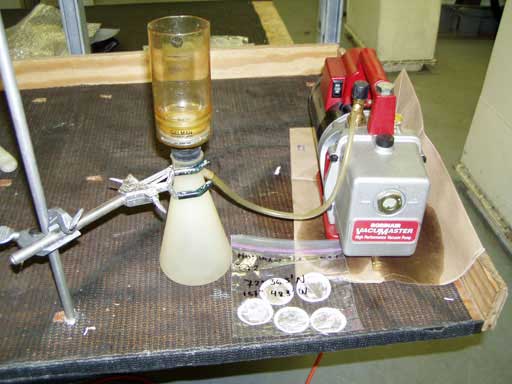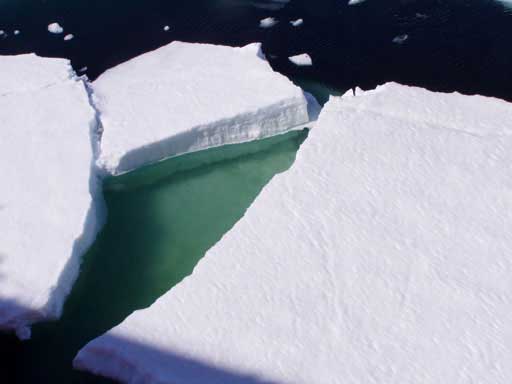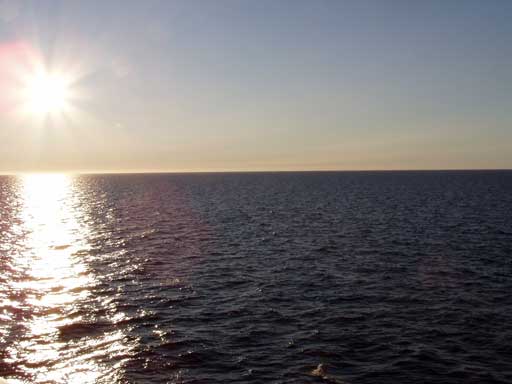( Log In ) Log In is for TREC Teachers & Researchers only
  |
| Steve_Marshall |
 Jun 28 2005, 06:04 PM Jun 28 2005, 06:04 PM
Post
#1
|
 TREC Teacher    Group: TREC Team Posts: 78 Joined: 27-April 05 Member No.: 12 |
Saturday, June 25
ANYTHING BUT ROUTINE The expectation that today would be a full day was NOT unfulfilled. Immediately after breakfast, I was put in charge of filtering the sediment we had collected from our helicopter flights looking for dirty sea ice. The filtering equipment was a relatively easy setup; It was basically a vacuum pump attached to a flask which would suction the water through a filter and leave the sediment behind on the filter paper. Setting the equipment up was relatively fast because the part that held the sediment and water was held magnetically to the part attached to the flask, with the filter paper between. The filtering process itself, however, took a little bit of time since the filters quickly became blocked by the sediment. I was glad to be directly involved with this procedure since one of the questions I was asked was a description of the sea ice samples. My original reply was mostly confirmed because the majority of the sediment was silt or clay sized. To give a rough idea of the proportion of sand to silt and clay, if a sample took six filters to process, only the last filter would have sand on it, and that would be very fine sand mixed with still more silt and clay. One thing that was different from my original reply was that it seemed to be a uniformly gray color, not gray and rust-colored as I originally mentioned. Ready for Action  This was the setup for filtering the dirty ice samples. Some of the filter paper with sediments already on it are shown in the plastic bag at the front of the table Replacing the Filter  This setup shows the equipment with the water/sediment holder removed, so a new filter can be placed over the flask as shown Pouring in the Water/Sediment Mixture  Once the holder is attached over the filter (the pieces are magnetic, so they just kind of snap together), the melted dirty ice can be poured into the holder as I’m doing here (photo by Joseph Ortiz) Muddy Water  After the mixture is poured, the vacuum pump is turned on which allows the water to pass through the filter and leave most of the sediment behind on the filter paper While I continued with the sea-ice samples, other people were retrieving the multi-core we had put in the water earlier. I have to admit, I wasn’t following my own advice that I have been giving throughout these entries about not taking anything for granted, because the multi-cores were becoming routine to me. As if someone was reminding me not to let that happen, this multi-core was anything BUT routine. One of the scientists working on the multi-corer came in and said I has to take a look, and to make sure I brought my camera. I soon found out why. Every core was packed with brittle stars, worms, and other comparatively large organisms. Since the core openings are relatively small in diameter, my immediate thought to myself was, “It would be incredible to see what the seafloor looks like here!…It must be covered with hundreds, if not thousands of these organisms, forming a thick layer of sea life.” I was so amazed that my camera was firing of picture after picture (and a few others’ cameras were busy too!). As the cores were emptied, we took some of the samples and rinsed them off, providing a clearer picture of just how large a variety of life is present here. The large amount of plankton in the Arctic was enough of a surprise, but to see such a wide variation of larger organisms was definitely unexpected. Having a Bad Day  This brittle star probably had no clue it was going to be brought 300feet to the surface inside a core today! Digging in the Dirt  This illustrates how a brittle star can dig down into, and mix up, the sediment. More Than Just Brittle Stars  This picture shows a shrimp-like arthropod (orange) and a soft coral (white, feathery looking organism) to the right of the arthropod. The ruler is shown at the bottom for scale (large divisions are inches on the left, centimeters on the right) The Whole Gang  This picture shows the arthropod (orange, front), soft coral (white, right), and a brittle star (back). It’s amazing such a diversity could be caught in such a small area Even More Things  When we combined the sediments and rinsed them off, an even wider diversity of life was revealed. Interesting…  I thought this orange thing looked really interesting. It wasn’t confirmed whether this was some type of sea cucumber, worm, or some other animal. Close-Up Shot  This shows some of the organisms in a little more detail Stressing Out  I don’t know if it was a lack of water, or just a normal movement, but you can see the orange worm-like organism is extending out from its rougher exterior more than it was previously After another multicore, again filled with similar animals as in the previous one, the CTD profiler was the next instrument to be deployed. Again, nothing was routine here, but in this case it wasn’t a good thing. It seems with the CTD studies on this cruise that the lack of routine was due to the fact we never knew what was going to go wrong with it this time. The culprit this time was a loss of power to the profiler about halfway back up to the surface. One thing that WAS better than previous runs was that all 24 niskin bottles collected water, but they did not collect it in sequential order, so that was a little bit of a problem. Next up was our last piston core. This ended up to be another successful coring operation, but it was also special in that it was the last core by our chief coring engineer, Pete Kalk, who is retiring after this cruise. Because he has such great expertise, and is well-known by the Coast Guard crew technicians, they gave him a special ceremony. There wasn’t much time to dwell on this, though, because we were having to break down the core fast enough to leave time for all the packing and cleanup we had yet to do. To be a little more efficient, some people worked hard to pack and clean up what we could, and others worked on sectioning and labeling the cores. Getting Marked  Dennis Darby (back) takes some of the mud off the piston core to write “LC” for “last core” on Pete Kalk’s helmet to commemorate the last core Pete will drill before his retirement (photo by Louis Whitcomb) Going Out in Style  Pete proudly showing his “LC” helmet (photo by Louis Whitcomb) The core was processed in record time, and much of the cleaning was done by dinner, so after dinner, there was a little time to just relax. I went out on the deck and noticed the water had significantly changed in color. Instead of that clear, light blue we were used to, the water was greenish brown. One of the scientists explained that this was the edge of the ice pack. In this area, where the ice is melting back, the ice releases large amounts of nutrients that had been trapped in the ice. This release of nutrients creates an area of high productivity…In other words, a plankton bloom. It is this explosion of microscopic plant growth that gives the water its color. Needless to say, the scientists couldn’t resist doing one last plankton tow. Noticeable Change  The pool of water between the two icebergs shows how it has changed to a much more brownish-green water as compared to the light blue water it was previously. This is due to a large amount of plant algae in the water. Still later, I went out on deck again, and realized for the first time that we were in open waters with the exception of a few small icebergs. It was strange to actual waves traveling across wide, open water…The Arctic now looked like a “regular” ocean. The Hawaii crew took advantage of this situation, and decided to deploy the IMI again. Since there is little setup and breakdown time associated with this device, they could wait to the last minute to bring it back in. And they almost did just that. They put it in the water in the late afternoon, and didn’t bring it back out until 2:00 am! Hopefully this amount of time resulted in some valuable data. As I was watching the IMI being brought back in, I noticed we were now close enough to Barrow to see land…Our cruise would soon be coming to and end….or would it? Big Change  I had been so used to the surrounding scenery being mostly ice, it was a surprise to notice we were back water that only had a stray iceberg floating around Nice Reflection  The Arctic now looked like a “regular” ocean, complete with nice reflections of the sun off the water Land in Sight  We knew the journey would soon be coming to a close when we could see Barrow on the horizon. |
  |
2 User(s) are reading this topic (2 Guests and 0 Anonymous Users)
0 Members:

|
NSF Acknowledgment & Disclaimer | Time is now: 11th November 2024 - 06:40 PM |
Invision Power Board
v2.1.7 © 2024 IPS, Inc.








